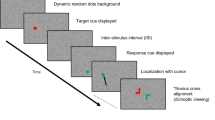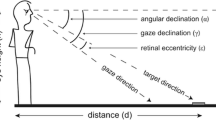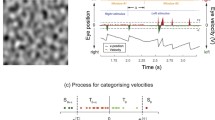Abstract
In order to reveal the mechanism of eye position coding, we measured the effect of eye position on assessing the position of a light viewed in a dark environment using a sound as a reference point, before and after adapting to prolonged periods of eccentric viewing (11° right or left). During testing, eye position was varied over ±22°. For each test position, a PEST procedure was used to align the perceived position of a light (with no visual reference points) and a fixed sound source. The perceived position of the light was veridical when looking straight ahead but large and consistent errors were found with eccentric viewing indicating that only about 77% of the eye eccentricity was taken into account, an eye position gain of 0.77, consistent with previous reports. The error was altered by prolonged eccentric viewing. There were two components to this effect: a direction bias and a gain change. The direction bias was symmetric: in a change rather like that induced by prism adaptation, the perceived straight ahead moved in the direction of the previous eccentric viewing. The gain change was asymmetric: after looking to the left, the gain of eye position increased to closer to one (0.77–0.81), in other words the subjects became more accurate. After looking right, the gain of eye position decreased (0.77–0.73): subjects consequently became less accurate. We model these systematic changes in terms of an asymmetric coding system.






Similar content being viewed by others
References
Andersen RA, Bracewell RM, Barash S, Gnadt JW, Fogassi L (1990) Eye position effects on visual, memory, and saccade-related activity in areas LIP and 7A of Macaque. J Neurosci 10:1176–1196
Aubert H (1886) Die Bewegungsempfindung. Pflügers Archiv Eur J Physiol 39:347–370
Aubert H (1887) Die Bewegungsempfindung. Zweiter Mitteilung. Pflügers Archiv Eur J Physiol 40:459–480
Becker W, Jurgens R (1979) An analysis of the saccadic eye movement system by means of double step stimuli. Vision Res 19:967–983
Blouin J, Gauthier GM, Vercher JL (1995) Internal representation of gaze direction with and without retinal inputs in man. Neurosci Lett 183:187–189
Bremmer F, Distler C, Hoffman KP (1997a) Eye position effects in monkey cortex. 2. Pursuit-related and fixation-related activity in posterior parietal areas LIP and 7A. J Neurophysiol 77:962–977
Bremmer F, Ilg UJ, Distler TC, Hoffmann KP (1997b) Eye position effects in monkey cortex. 1. Visual and pursuit-related activity in extrastriate areas Mt and MST. J Neurophysiol 77:944–961
Bremmer F, Graf W, Ben Hamed S, Duhamel JR (1999) Eye position encoding in the macaque ventral intraparietal area (VIP). Neuroreport 10:873–878
Bridgeman B, Stark L (1991) Ocular proprioception and efference copy in registering visual direction. Vision Res 31:1903–1913
Campbell FW, Maffei L (1970) Electrophysiological evidence for the existence of orientation and size detectors in the human visual system. J Physiol (Lond.) 207:635–652
Fleischl EV (1882) Physiologisch optische Notizen. Sitzungsbez Akad Wissensch 3:7–25
Freeman TC, Banks MS (1998) Perceived head-centric speed is affected by both extra-retinal and retinal errors. Vision Res 38:941–945
Fuchs AF, Luschei ES (1970) Firing patterns of abducens neurons of alert monkeys in relationship to horizontal eye movement. J Neurophysiol 33:382–392
Galletti C, Battaglini PP (1989) Gaze-dependent visual neurons in area-V3A of monkey prestriate cortex. J Neurosci 9:1112–1125
Harris LR (1997) The coding of self motion. In: Harris LR, Jenkin MR (eds) Computational and psychophysical mechanisms of visual coding. Cambridge University Press, Cambridge, pp. 157–183
Held R (1965) Plasticity in sensory-motor systems. Sci Am 213:84–94
Kalil RE, Freedman J (1966) Persistence of ocular rotation following compensation for displaced vision. Percept Mot Skills 22:135–139
Kohler W (1951) Ueber Aufbau und Wandlungen der Wahrnehmungswelt. Sitzungsber Oesterreichishe Akad Wiss 227:1–118
Lewald J (1997) Eye-position effects in directional hearing. Behav Brain Res 87:35–48
Lewald J (1998) The effect of gaze eccentricity on perceived sound direction and its relation to visual localization. Hear Res 115:206–216
Lewald J, Ehrenstein WH (1996) Auditory-visual shift in localization depending on gaze direction. Neuroreport 7:1929–1932
Maffei L, Fiorentini A, Bisti S (1973) Neural correlate of perceptual adaptation to gratings. Science 182:1036–1038
McFadden S, Wallman J (2001) Shifts of attention and saccades are very similar. Are they causally linked? In: Jenkin M, Harris LR (eds) Vision and attention. Springer, New York, pp. 19–39
McLaughlin S (1967) Parametric adjustment in saccadic eye movements. Percept Psychophys 2:359–362
McLaughlin SC, Webster RG (1967) Changes in straight-ahead eye position during adaptation to wedge prisms. Percept Psychophys 2:37–43
Mountcastle VB, Lynch JC, Georgopoulos A, Sakata H, Acuna C (1975) Posterior parietal association cortex of the monkey: command functions for operations within extrapersonal space. J Neurophysiol 38:871–908
Nakamura K, Chung HH, Graziano MSA, Gross CG (1999) Dynamic representation of eye position in the parietooccipital sulcus. J Neurosci 81:2374–2385
Park JN (1969) Displacement of apparent straight ahead as an aftereffect of deviation of the eyes from normal position. Percept Mot Skills 28:591–597
Poulton EC (1989) Bias in quantifying judgements. Erlbaum, Hove
Rosenbluth D, Allman JM (2002) The effect of gaze angle and fixation distance on the responses of neurons in V1, V2, and V4. Neuron 33:143–149
Sakata H, Shibutani H, Kawano K (1980) Spatial properties of visual fixation neurons in posterior parietal association cortex of the monkey. J Neurophysiol 43:1654–1672
Taylor MM, Creelman CD (1967) PEST: efficient estimates on probability functions. J Acoust Soc Am 41:782–787
Templeton WB, Howard IP, Lowman AE (1966) Passively generated adaptation to prismatic distortion. Percept Mot Skills 22:140–142
Trotter Y, Celebrini S (1999) Gaze direction controls response gain in primary visual cortex neurons. Nature 398:239–242
Vindras P, Viviani P (2002) Altering the visuomotor gain. Evidence that motor plans deal with vector quantities. Exp Brain Res 147:280–295
Von Helmholtz H (1911) Handbuch der physiologischen Optik, 3rd edn. Voss, Leipzig
Acknowledgments
LRH was supported by the Natural Sciences and Engineering Research Council of Canada. Many of these experiments were run by Michael Barnett-Cowan and Jeff Sanderson who were graduate students in LRH’s lab.
Author information
Authors and Affiliations
Corresponding author
Rights and permissions
About this article
Cite this article
Harris, L.R., Smith, A.T. The coding of perceived eye position. Exp Brain Res 187, 429–437 (2008). https://doi.org/10.1007/s00221-008-1313-0
Received:
Accepted:
Published:
Issue Date:
DOI: https://doi.org/10.1007/s00221-008-1313-0




